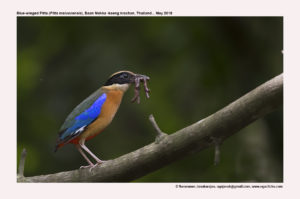
Blue-winged Pitta Pitta moluccensis
Etymology:
- Pitta : Telugu Dravidian name pitta – Pretty, Pet
- Moluccensis: From Malacca in Malaysia
Distribution in India: Winter visitor in Narcondam Island in India.
Description: Size 18–20 cm; wt. of 54–146 g. The adult has a blackish head with broad buffy brown sides of crown and buffy supercilium; upperparts are dark green, rump is turquoise-blue, tail is black with blue-green tip; inner half of wing are turquoise-blue, primaries are black with broad white band; throat is white, rest of underparts are cinnamon-buff, with center of belly to undertail-coverts as crimson; iris is red-brown to dark brown; bill is blackish; feet range from pale brown with lilac tinge to pale fleshy. Both the sexes are alike.
Habitat: It is found in moist or dry primary forest with dense or sparse undergrowth to mixed deciduous forest, secondary forest, scrub, bamboo; mangroves, plantations and even parks and gardens on migration. It is found in lowlands up to 800 m in breeding season and from up to 1800 m on migration and in non-breeding season.
Food Habits: It eats insects like scarab beetles, grasshoppers, hornets, ants, fireflies or glow-worms and bugs, and variety of insect larvae; also eats spiders, earthworms, snails and crustaceans. It uses stones as “anvils” when cracking snail shells. It forages on ground and hops in manner of a thrush.
Breeding Habits:They breed in Apr–Aug in Thailand. The nest is a very untidy structure mostly made of twigs, leaves (often of bamboo) and roots, lined with fibers, and placed on ground. They lay a clutch of 3–7 eggs. Both the sexes incubate. The incubation period is 18 days. Both the parents feed the young.